📋 GD Guide: Can Online Education Replace Traditional Schooling?
🌐 Introduction to the Topic
Opening Context: Online education has emerged as a revolutionary alternative to traditional schooling, reshaping how we perceive learning in the digital age. Its potential to bridge geographical and financial gaps makes it highly relevant for B-school aspirants.
Topic Background: The COVID-19 pandemic accelerated the adoption of online education globally, raising questions about its long-term viability as a replacement for traditional schooling.
📊 Quick Facts and Key Statistics
– 🇮🇳 India’s EdTech Market: Worth $5 billion in 2024, expected to reach $10 billion by 2025.
– 🧠 Student Engagement: 45% of students globally report decreased attention spans in online classes (2023 survey).
– 🌐 Access Gap: 60% of rural households in India lack stable internet connectivity, affecting online learning.
👥 Stakeholders and Their Roles
- 🏛️ Governments: Policymaking for digital infrastructure and equitable education access.
- 💻 EdTech Companies: Developing engaging, scalable learning platforms.
- 📚 Educational Institutions: Blending traditional and digital methods to enhance learning outcomes.
- 👨👩👧👦 Students and Parents: Adapting to new modes of learning and supporting digital transformation.
🏆 Achievements and Challenges
✨ Achievements:
- ✔️ Flexibility and accessibility for remote learners.
- ✔️ Cost-effective alternatives to traditional education.
- ✔️ Enhanced personalization through AI-driven platforms.
⚠️ Challenges:
- 🚧 Digital divide limiting equitable access.
- 🚧 Reduced peer interaction and soft skills development.
- 🚧 Screen fatigue and declining attention spans.
🌍 Global Comparisons:
- 🇪🇪 Estonia: Leading in digital learning due to robust digital infrastructure.
- 🇫🇮 Finland: Successfully integrating hybrid learning models.
💡 Structured Arguments for Discussion
✔️ Supporting Stance:
“Online education democratizes learning by making it accessible to anyone with an internet connection.”
❌ Opposing Stance:
“Lack of social interaction in online education hampers holistic development.”
⚖️ Balanced Perspective:
“While online education offers unparalleled flexibility, it cannot entirely replicate the immersive experience of traditional schooling.”
🧠 Effective Discussion Approaches
📝 Opening Approaches:
- 📊 “With the EdTech market growing at 14.6% annually, can online education truly match traditional schooling in effectiveness?”
- 🔄 “Online classes offer flexibility, but traditional schooling fosters critical social skills.”
🛠️ Counter-Argument Handling:
- Acknowledge the need for personalization in online education.
- Present hybrid learning as a solution combining the best of both worlds.
🔍 Strategic Analysis of Strengths and Weaknesses
💪 Strengths:
- ✔️ Accessibility.
- ✔️ Affordability.
- ✔️ Personalized learning.
❌ Weaknesses:
- 🚧 Digital divide.
- 🚧 Lack of hands-on learning.
🌟 Opportunities:
- 📈 Integration of VR/AR for immersive experiences.
- 📈 Global course access.
⚡ Threats:
- ❓ Cybersecurity risks.
- ❓ Over-reliance on technology.
📈 Connecting with B-School Applications
Real-World Applications: Explore hybrid models in educational entrepreneurship or operational strategies.
Sample Questions:
- 💬 “What is your opinion on the long-term viability of online education?”
- 💬 “How can EdTech be leveraged for inclusive growth?”


